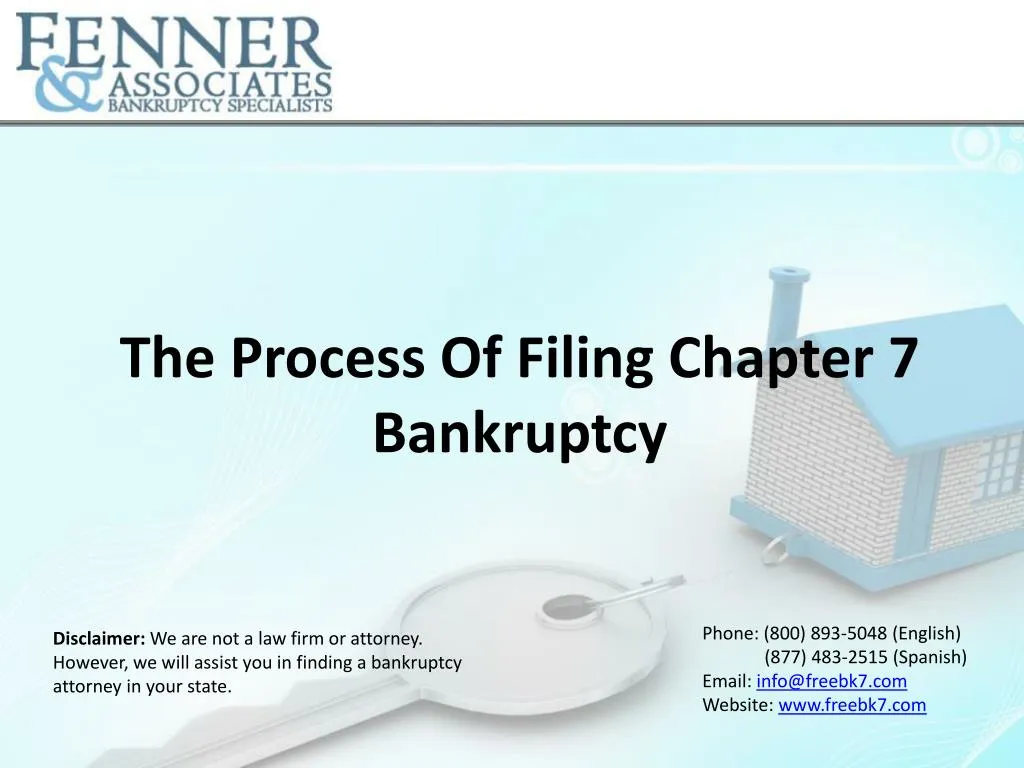How Hard is Filing Chapter 7 Paperwork Really?

When you're considering filing for bankruptcy under Chapter 7, the paperwork involved can seem daunting. Many people have heard tales of piles of documents and endless hours spent understanding legal jargon. However, with a bit of organization and knowledge, filing Chapter 7 paperwork is manageable. Let's delve into what this process entails and how to navigate it effectively.
Understanding Chapter 7 Bankruptcy

Before diving into the paperwork, understanding what Chapter 7 bankruptcy entails is crucial:
- Liquidation: It’s also known as “liquidation” bankruptcy, where your non-exempt assets might be sold to pay creditors.
- Debt Discharge: Most unsecured debts like credit card debt, medical bills, and personal loans can be discharged.
- Means Test: Your eligibility for Chapter 7 is determined through a means test, which compares your income to the median income of your state.
Preparation: Gathering Documents

The first step in filing for Chapter 7 is to gather all necessary documents:
- Income Verification: Pay stubs, bank statements, and tax returns for the past 6-12 months.
- Debt Documentation: List of all creditors with account numbers, balances, and copies of bills or statements.
- Asset Verification: Proof of ownership for any assets like property, cars, or valuables.
- Expenses: Detailed records of monthly expenses including utilities, insurance, and household costs.
- Other Legal Documents: Divorce decrees, child support orders, or any lawsuits you’re involved in.
Completing the Bankruptcy Forms

The following are the primary forms you’ll need to fill out:
| Form Number | Description |
|---|---|
| B 101 | Voluntary Petition for Individuals Filing for Bankruptcy |
| B 106 Sum | Summary of Your Assets and Liabilities and Certain Statistical Information |
| B 106A/B | Schedules A/B – Property |
| B 106C | Schedule C – The Property You Claim as Exempt |
| B 106D | Schedule D – Creditors Holding Secured Claims |
| B 106E/F | Schedules E/F – Creditors Holding Unsecured Claims |
| B 106G | Schedule G – Executory Contracts and Unexpired Leases |
| B 106H | Schedule H – Your Codebtors |
| B 106I | Schedule I – Your Income |
| B 106J | Schedule J – Your Expenses |
| B 106Dec | Declaration About an Individual Debtor’s Schedules |
| B 107 | Your Statement of Financial Affairs for Individuals Filing for Bankruptcy |
| B 122A-1 | Chapter 7 Statement of Your Current Monthly Income |
| B 122A-2 | Chapter 7 Means Test Calculation |

Here are some notes to keep in mind:
📝 Note: Accuracy is paramount; errors or omissions can delay your bankruptcy filing or result in dismissal.
📝 Note: If you have a lot of paperwork, organize it in folders by category for easy reference during the process.
Means Test and Eligibility

One of the critical aspects of Chapter 7 is passing the means test. Here’s how to approach it:
- Income Comparison: Compare your average monthly income from the last 6 months to your state’s median income. If below, you automatically pass the means test.
- Expense Deductions: If your income is above the median, you’ll need to show allowable expenses to lower your disposable income.
- Pass or Fail: Passing the means test allows you to proceed with Chapter 7; failing might mean you need to consider Chapter 13.
Meet and Discuss with Your Attorney

While not legally required, having an attorney can significantly simplify the process:
- Legal Advice: They provide expert guidance through legal complexities and potential pitfalls.
- Documentation: An attorney will ensure you file all necessary forms accurately and on time.
- Representation: They can represent you in court or during the 341 Meeting of Creditors.
The Filing Process

Once all your paperwork is prepared:
- File Petition: Submit the voluntary petition and accompanying schedules to the bankruptcy court in your jurisdiction.
- Automatic Stay: Filing triggers an automatic stay, halting most collection activities from creditors.
- 341 Meeting: Attend the 341 Meeting of Creditors where you’ll be examined under oath by your trustee.
📝 Note: A good preparation for the 341 Meeting includes reviewing your forms and practicing answering potential questions.
Post-Filing Responsibilities

After filing:
- Provide Additional Information: The trustee might request additional documents or explanations.
- Complete Financial Management Course: You’re required to take a debtor education course within 60 days of your meeting of creditors.
- Discharge: If everything goes smoothly, you’ll receive your discharge order, releasing you from most debts.
Wrap-Up

Filing for Chapter 7 bankruptcy, while initially appearing complex, becomes manageable through careful preparation and understanding of the process. You can navigate through the paperwork by organizing documents, understanding the forms, and perhaps seeking professional guidance. Although it’s a major step, bankruptcy can offer a fresh financial start, discharging unsecured debts and stopping creditor harassment. Remember, preparation is key, and having support can make this challenging time smoother.
Do I need an attorney to file for Chapter 7 Bankruptcy?

+
While it is possible to file for Chapter 7 without an attorney, having one can significantly simplify the process by providing legal advice, ensuring accurate filing, and representing you in court.
What happens to my property in a Chapter 7 bankruptcy?

+
Some of your property might be sold by the trustee to pay off creditors if it’s not exempt. However, many personal items and basic necessities are exempt under state laws, allowing you to keep them.
How long does a Chapter 7 bankruptcy take?

+
From filing to discharge, a Chapter 7 bankruptcy typically takes about 3 to 4 months if there are no complications. However, the exact timeline can vary.